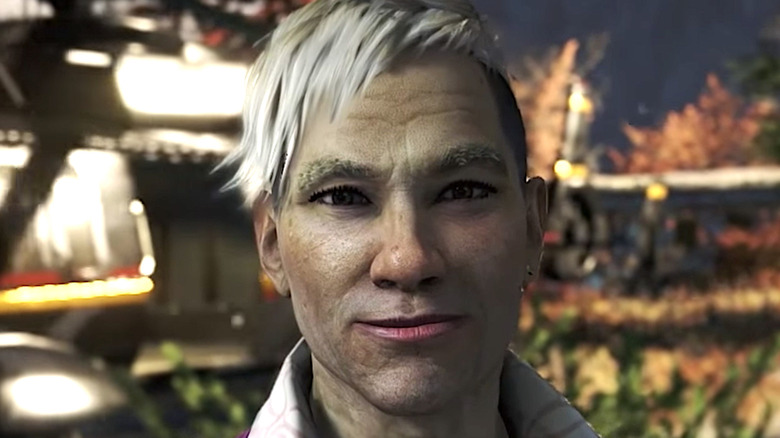The Most Bizarre Alternate Endings In Games
All good things must come to an end, and video games are no exception. But while some interactive journeys aim to leave a lasting emotional impact and move players to tears, others opt to inspire head-scratching confusion—that, or side-splitting hilarity. With this in mind, let's take a look at some of the most bizarre alternate endings in popular video games.
Far Cry 4
Far Cry 4's protagonist Ajay just wanted to fulfill his mother's dying wish by bringing her ashes back to her home country of Kyrat to be placed beside those of her late daughter, Lakshmana. But instead, his rebellious streak leads to him being thrust into a bloody conflict between tyrannical dictator Pagan Min's Royal Army and the Golden Path, a militia of Kyrati rebels. What many impatient gamers may not realize, however, is that waiting all of 15 minutes at the beginning of the game results in a surprisingly moving ending free of bloodshed, international conflict, and, well, any actual gameplay.
After Min shuttles the player back to his humble abode and tells Ajay to hold his horses as he takes a call, players are given the choice to either begin the actual game or follow the tyrant's orders and stay put. The former means entering the brutal civil war, guns a-blazin'. The latter, however, results in an alternative ending that sees Min doing his good deed for the day and giving Ajay the opportunity to put his mother to rest. Think of it as the "happy ending." Well, it's a happy ending for Ajay—not for the countless oppressed Kyrati civilians under Min's iron fist, mind you.
Metal Saga
Twenty-first century RPG players are accustomed to their in-game choices resulting in dramatic consequences down the line. Atlus' Metal Saga, for better or for worse, doesn't play by these rules. The role-playing game begins with the main character receiving the option to either pursue his father's career as a hunter or become a mechanic—his mother's occupation. The protagonist's mother doesn't hide her disdain for hunting, though choosing that path kicks off an exciting adventure through the game's wacky post-apocalyptic world. If the player decides to follow in mom's footsteps and become mechanic, the game abruptly comes to a close—but not before trolling them for their poor career choice.
The game time-jumps, cutting to a scene where the protagonist's mother praises him for becoming "the best mechanic around." It then shows his sister and his father at the dining room table, as the two talk about all the ways that the player let dear old dad down. Finally, a text-only epilogue details all of the exciting adventures the now-mechanic could have had if he'd taken up arms as a hunter, explaining that the player would die peacefully after "one of the most boring lives ever imagined." Hey—an ending is an ending, right? Just be sure to hit the reset button and start the game off properly next time.
Deus Ex: Invisible War
The alternate ending to stealth shooter RPG Deus Ex: Invisible War is as bizarre as it is satisfying, if only because it demands the desecration of UNATCO property. To earn it, players need to reach the final area, carry a UNATCO flag to the trash heap that was once Joseph Manderley's office, and flush said banner down the toilet in his bathroom.
What's the result of this bit of unpatriotic plumbing? Players who make it to the last level of the game, the ruins of UNATCO Headquarters, are treated to a trippy dance party featuring flaming penguins, meta datacubes, and the title's cast of characters getting down at Upper Seattle hot spot Club Vox.
Most of the Silent Hill games
Konami's psychological survival horror series is known for its many alternate endings, each of which depends on gamers' play styles. For instance, neglecting to treat a main character's wounds might result in a grisly conclusion that sees the tormented protagonist taking his own life. But not every ending takes itself so seriously—especially when extraterrestrials get involved. Silent Hill's infamous "UFO Endings," which appear in all but two of the games, depict huge-headed aliens either abducting the protagonist or laying waste to titular town. But don't worry about stumbling into one of these comic-style endings accidentally—they require the player to perform extremely specific actions, like killing 30 monsters using Heather's "Heather Beam" in Silent Hill 3.
Sure, these endings aren't exactly canonical, and they're best left for completionists who've unlocked all the other conclusions. But there's something morbidly satisfying about seeing an everyman who's risked life and limb to escape the nightmarish town abducted by '50s-style Martians. Almost makes you miss the skull-faced nurses and pyramid-headed executioners, huh?
Silent Hill 2
One of the Silent Hills series' most notorious endings, however, has nothing to do with grim rituals, suicides, or even unearthly abductions—and everything to do with a super-intelligent dog. Silent Hill 2's "Dog Ending" has gone down in gaming history as one of the franchise's kookiest conclusions. The appropriately named endgame depicts a meeting between protagonist James and a Shiba Inu named Mira. Turns out Mira's been controlling the game's surreal happenings via a colorful control panel in a hidden room only unlockable with a hidden key on a player's second or third play-though. Like the aforementioned UFO endings, Mira's tech-induced nightmare is an Easter egg reserved for players who've already put their traumatized hero through the wringer.
Pikmin
While we're on the subject of games with endings that don't match their genre, Nintendo's cutesy Pikmin offers an alternate ending straight off the pages of a Resident Evil script. If Captain Olimar, The game's protagonist, doesn't manage to collect the necessary parts to fix his rocket and return home, the intergalactic traveler will buckle under pressure. In an attempt to escape the strange planet upon which he's been stranded, his ship will jettison into the sky... only to crash right back onto the planet's surface. Awaiting him, of course, are the Pikmin he's befriended along his journey. But instead of welcoming him back with open arms, the critters will carry his lifeless body into an Onion—a Pikmin nest—and transform him into one of them. Unfortunately, Olimar's biology doesn't quite adapt to his new form. Instead of metamorphosing into a cuddly plant-sprite, the poor spaceman will find himself twisted into a creepy alien-Olimar hybrid. Sorry, spaceguy. You're a plant zombie now.
Mass Effect 2
Depending on gamers' play styles, Mass Effect 2's worst possible ending might be exactly what Shepard deserves—if he's gone full renegade by the time the sci-fi RPG's "Suicide Mission" rolls around. This tragic ending is reserved for players who've managed to neglect their companions' loyalty missions while simultaneously choosing the wrong characters to carry out the final mission's many components.
The collapse of the Normandy's crew sees every member of the legendary ship—with the exception of Joker—dispatched as the hapless Commander Shepard's many missteps spell doom for the galaxy. Canonically, earning this ending means players can't carry their data over to Mass Effect 3... seeing as all of their friends and crewmates are dead.
Final Fantasy X-2
Fortunately for the masochistic gamer in all of us, Mass Effect 2 isn't the only game to reward?—taunt?—players unsuccessful enough to lose their lives in battle. Final Fantasy X-2 features a similar alternate ending whereupon the entire world is blown to smithereens by big bad Titus-lookalike Shuyin. If Yuna and party fall victim to monstrous machina Vegnagun in battle, FFX-2 swaps out a traditional "game over" screen for one of the most disturbing cutscenes in the game. In a display of its sheer destructive capabilities, the Vegnagun fires a blast of concentrated energy into the sky. Cut to the peaceful Calm Lands torn from the earth as civilians run fruitlessly from a devastating attack that lays waste to the entire world of Spira.
Chrono Trigger
With a colorful cast of characters, a lengthy and whimsical journey across time, and multiple endings, Chrono Trigger revolutionized the console JRPG genre. Of the 13 possible finales awaiting Chrono and company, one specific denouement stands out as the most peculiar—and the most difficult to attain. If players defeat Lavos early in the game using only Chrono—or, alternatively, if they defeat an overpowered version of the bad guy in the Ocean Palace—they're transported to The End of Time, where they're greeted by creatures and NPCs representing the various developers who worked on the game. Some will crack jokes, others will congratulate the player, and still others will pull pranks—like pretending to reset the game or forcing you to battle one last group of mobs.
After talking to the entire development team, Gaspar the Guru of Time will "open the Gates to the Dream Team," introducing the player to the five legendary video game icons responsible for Chrono Trigger: Akira Toriyama, Nobuo Uematsu, Yuji Horii, Kazuhiko Aoki, and Hironobu Sakagushi.
Nier
Nier was a fantasy action RPG that, like its successor, the 2017 smash hit NieR: Automata, boasts a number of endings. The catch? Unlocking these endings required players to jump back into the eponymous hero's shoes, replaying the events of the main game over and over. While each of the endings is unique in its own right, it's the fourth ending—Ending D—that's become one of the most notorious video game endings of all time. In it, Nier sacrifices his life to save the life of Kainé. However, in giving his life for hers, Nier is wiped from the memories of all those who've ever known him—including the player.
Upon choosing to sacrifice Nier, the game forces the player to watch as all of their data is deleted along with all of their progress, all of the quests they've completed, all of their items, weapons, memos, keys—everything. And don't bother trying to start a new game using the same name of the hero that you just erased from existence. The game won't let you.


